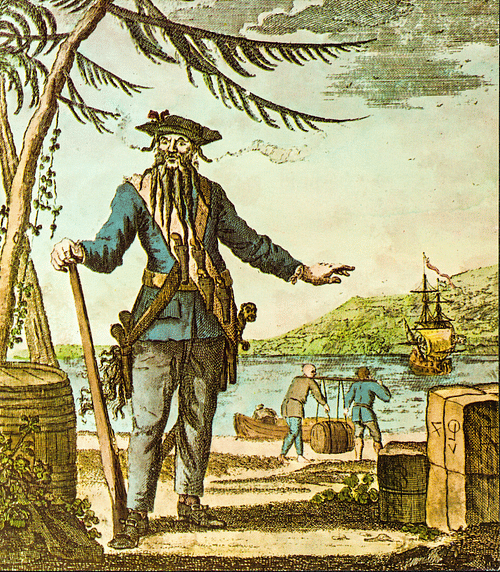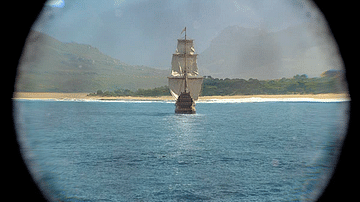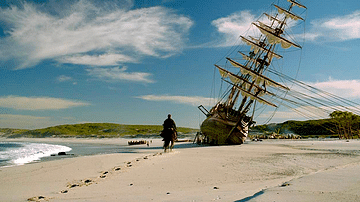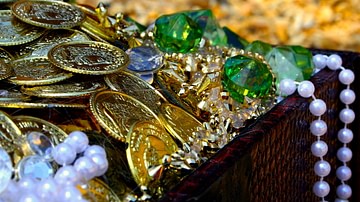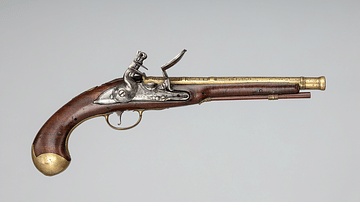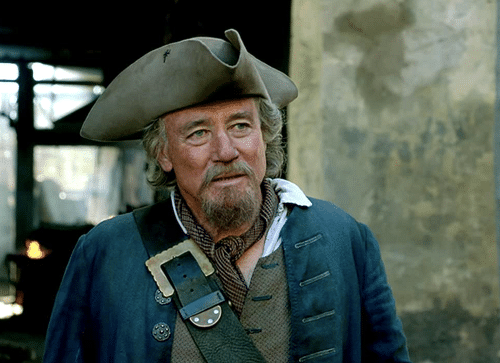
Captain Benjamin Hornigold was a British pirate active in the Caribbean and North Atlantic from 1716 to 1717. Hornigold’s greatest claim to fame (or infamy) is that he taught the pirating ropes to Edward Teach, aka Blackbeard (d. 1718). Giving up his pirate activities in exchange for an official pardon, Hornigold was enlisted by the governor of the Bahamas to chase down other pirates, which he did with success. Captain Hornigold died on a desert island after being shipwrecked in 1719.
Hornigold & Blackbeard
Part of Benjamin Hornigold’s story is told in the celebrated pirate’s who’s who, A General History of the Robberies and Murders of the Most Notorious Pyrates, compiled in the 1720s by Charles Johnson/Daniel Defoe. Combined with this there are trial transcripts that record Hornigold's deeds, particularly his transformation from pirate captain to pirate hunter for the governor of the Bahamas.
Hornigold, like many other pirates in the so-called Golden Age of Piracy, was based in the pirate haven of New Providence Island in the Bahamas. He had established himself there between 1713 and 1716 after formerly serving the British government as a privateer against Spanish and Portuguese vessels. The haven became a notorious den of iniquity where pirates could trade their booty with dishonest merchants and enjoy the pleasures of shore life: wine, women, and song.
Amongst Hornigold’s crew were some soon-to-be-famous pirates. One was Samuel Bellamy (d. 1717), who was given a captured eight-gun sloop by Hornigold, the Mary Anne. Bellamy was one of the few pirates to die not being shot or hanged, he kicked the bucket in a storm off Cape Cod. Another associate of Hornigold’s was the French pirate Olivier La Bouche.
Pirate leaders often commanded a fleet of several ships, and Hornigold was no different. In September 1717, Hornigold promoted another not-yet-infamous member of his crew to the position of subordinate captain, the Englishman Edward Teach, better known to history as Blackbeard. Teach had joined Hornigold’s band of pirates in the Bahamas the year before. Hornigold gave Teach command of a captured sloop, and the pair went on to attack ships in the Caribbean and off the coast of North America with great success. They operated in consort, that is, all booty taken was shared equally, no matter by which captain, and even if the two ships were separated. Ships of all sorts plying the trade routes between Cuba, Bermuda, the Caribbean islands, and North America were plundered, and valuable if unglamorous cargo was taken like kegs of wine and barrels of flour.
A notable capture of the Hornigold-Teach partnership was the Concorde, a French ship on its way to Martinique loaded with gold dust, coinage, gems, and other precious goods accumulated from various trading posts in Africa. Teach took over this vessel in November 1717 near St. Vincent. The booty was divided equally between Teach, Hornigold, and their respective crews. Teach renamed his new pirate ship the Queen Anne’s Revenge. Fitted out with 40 cannons, which equalled the firepower of many naval vessels, Blackbeard, as he was to become better known, would use this formidable ship to outdo Hornigold in his life of crime. The profitable pairing now split amicably. Blackbeard sailed off to plunder the coast of North America while Hornigold remained in Caribbean waters. Blackbeard was eventually killed in a battle with two Royal Navy ships in November 1718.
Pardon in the Bahamas
Captain Hornigold, meanwhile, decided to take up the offer of a royal pardon. While many governors and officials on the east coast of the American colonies and on the Caribbean islands had turned a blind eye to piracy - either because they were involved in it themselves or because pirate booty was often cheaper than buying goods from legitimate traders - times were changing. By the end of the 1710s, the British government and legitimate merchants were applying pressure on colonial governors to finally stamp out piracy. For this reason, on 5 September 1717, King George I of Great Britain (r. 1714-1727) issued a pardon for pirates willing to give up their hugely disruptive activities. Hornigold heard the news of this royal ticket to respectability from a ship sent by the Governor of Jamaica, Peter Hayward. Hornigold sent the following reply (spelling errors included):
This is to acquaint your Excellency that wee have mett with Capt Cook who hath brought us the wellcome Tydings of an Act of Grace from his majesty King George which wee embrace and return his Majesty our hearty thanks for the same. God save the king.
(Cordingly, 205)

Hornigold chose to take up the pardon from the newly appointed Governor of the Bahamas, Woodes Rogers (1679-1732) in July 1718, and he duly promised to turn over a new leaf. Ironically, this policy of the authorities backfired in the case of the Bahamas since, without piracy and the booming trade of pirate loot, the islands became something of a colonial backwater, and Rogers himself eventually ended up bankrupt.
A Pirate Hunter
Hornigold soon had an opportunity to practically demonstrate his honest intentions when Governor Rogers enlisted him to pursue pirates who had not accepted the king’s pardon. Hornigold’s first target was the English pirate Charles Vane, who had been causing all sorts of trouble in the Caribbean and the coast of North America since 1716. He was Governor Rogers’ prime target since Vane had audaciously fired on his ship when the pirate had fled New Providence harbour in August 1718. However, Vane was known for his preference for fast ships, and Hornigold could not pursue him. Vane would be captured in 1720 after his ship was shipwrecked; he was hanged the next year.
Hornigold was then tasked with hunting down John Augur (sometimes spelt Auger), a pirate who had recently hijacked three supply ships sailing from New Providence. Augur had just received a pardon but obviously could not resist the allure of piracy. To turn from pirate to pardoned citizen and back to pirate again was the ultimate sin, and Rogers was determined to make an example of Augur. Hornigold commanded one vessel while Captain Cockram sailed another to chase down Augur, who was easily captured after he, too, had been shipwrecked on Long Island.

Augur and a number of other pirates were taken back to New Providence by Captain Hornigold, where they were tried for piracy. The trial was used by Rogers to publicly show his determination to catch any and all pirates and bring them to justice. The impressive body of judges consisted of seven commissioners who met in His Majesty’s Guard Room in Nassau on 9 December 1718. With the proceedings led by Rogers himself, the court heard testimony from witnesses and the ten men themselves. All of the men pleaded not guilty despite the overwhelming evidence against them. Nine men were convicted of piracy while one man, John Hipps, was given a reprieve after convincing the court that he had only been with the pirates under duress. The sentence for those found guilty was death by hanging.
Death & Legacy
The success of the Augur pirate hunt meant that Hornigold was entrusted by the governor with a voyage to pursue trade with ports in Mexico in 1719. This trip met with disaster when Hornigold's ship hit a reef. Hornigold was one of the small group of castaways that found themselves deposited on a desert island. While five men managed to build a canoe and escape, Hornigold died on the island.
Although not a particularly colourful or even successful pirate compared to figures like Bartholomew Roberts, Benjamin Hornigold has, at least, continued to grab the public’s imagination in the 21st century with his appearance as a character in such computer games as Ubisoft’s Assassin’s Creed IV: Black Flag and television programmes like Starz’s Black Sails.
